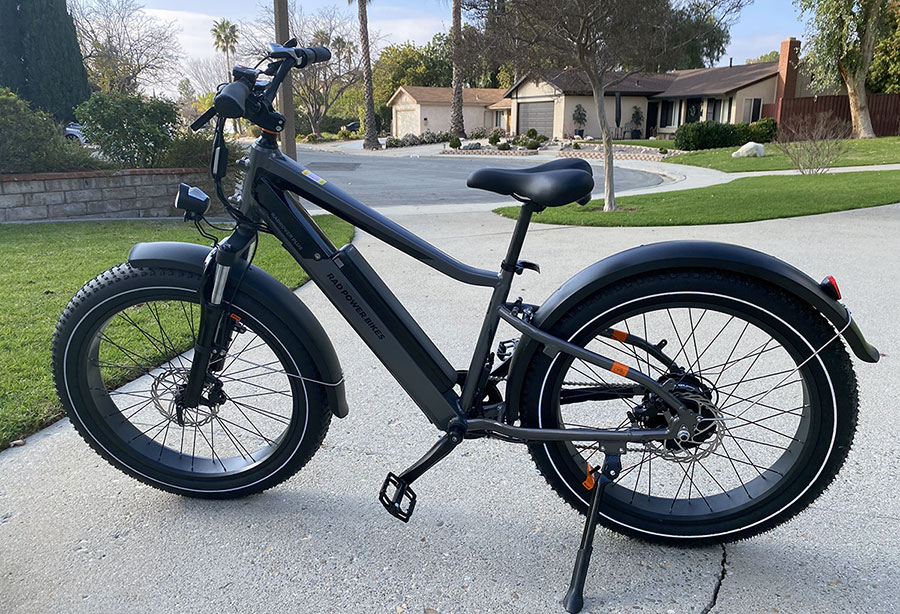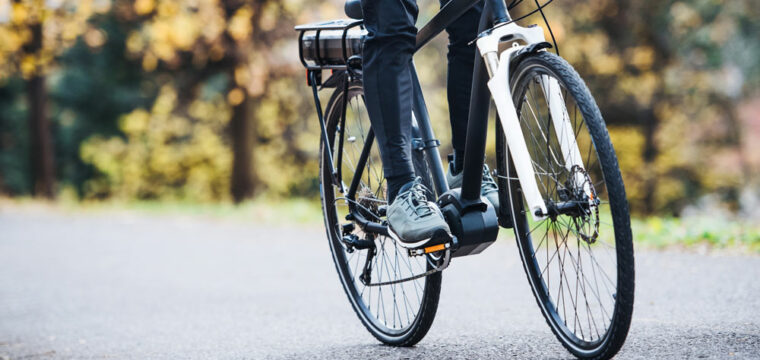Electric bikes have a reputation for being heavy, and compared to traditional bicycles, they are. The extra weight comes from the additional electrical components and other design modifications.
The average e-biker, like an urban commuter or recreational e-biker, may see weight as a secondary consideration. However, buyers of folding or performance e-bikes place higher importance on weight.
Even the lightest electric bikes are heavier than traditional bikes. Electric bike weight is usually around 50 to 70 lb, but this varies massively based on the type of bike and the price range. E-bike weight is also closely linked to range and power.
This article will explore the different design factors and components that make e-bikes so heavy, discuss the effect of weight on performance and functionality, and briefly mention the different styles of e-bikes and their average weights.
How Much Does an Electric Bike Weigh?
The average electric bike weight is around 55 lb, roughly double that of a traditional bicycle.
The weight of an e-bike is primarily determined by the style or discipline, price, accessories, range, and power.

An average commuter-style electric bike weighs around 50 lb, just like the Cannondale Adventure Neo Allroad pictured above. (Source: rei.com)
For example, styles such as road, gravel, and folding models are optimized for low weight. Other categories, such as commuter, fat tire, and cruiser, focus on comfort and functionality.
The average price of an e-bike is around $2,000 to $2,500. Most of the models in this range are urban hybrids. Bikes above this price range trend towards being lighter, while those below are usually heavier.
For example, even the best cheap electric bikes can easily weigh 70 lb. Conversely, expensive ebike models usually weigh closer to 50lb, but some best electric road bikes weigh around or below 30 lb.
What Is the Lightest Weight of an Electric Bike?
The lightest electric bike we’ve seen is Hummingbird’s carbon fiber folding model, at just 22.7 lb. Slightly higher at 24.9 lb is Cannondale SuperSix EVO Neo electric road bike.
On the other hand, Juiced Bikes makes some of the heaviest moped-style ebikes with dual-battery setup.
Why Are E-Bikes So Heavy?
E-bikes have electrical components that comprise most of the additional weight.
For example, we can compare the Trek Bikes Domane AL 5 (22.27 lb) and Domane+ AL 5 (31 lb), an endurance-style road bike. The difference between them is just 8.73 lb.
The electric version has an 8 lb Hyena Hydrive hub system, meaning the rest of the changes add up to less than one pound.

Ebike batteries are the heaviest part of an ebike, weighing up to around 20 lb.
In other cases, manufacturers will significantly alter the bike to support the extra weight of heavier electronics and the higher force being put through the drivetrain or on the wheels.
By reinforcing specific stress points on the frame and choosing more robust componentry, e-bike frames end up even heavier.
The discrepancy in weight between the lightest and heaviest e-bikes is enormous, and this can be seen in the individual components too.
- Hub motors can weigh anywhere from 4.6 lb (Mahle’s Ebikemotion X20) to 11 lb for some cheaper Bafang models.
- Mid-drive motors weigh from 4.3 lb (Fazua’s Evation) to 9 lb.
- The weight of e-bike controllers is roughly 1 lb.
- E-bike battery weight can be as low as 3.1 lb for a small 250W unit to 20 lb for 1,000W batteries.
- Extra cabling, casings for electric components, and a reinforced frame.
- More robust e-bike-specific components such as the chain and tires, and thicker spokes or wider rims.
Price, Power, and Range
Almost all low-cost electric bikes use hub drive motors because they are significantly cheaper than mid-drives. The problem is that they are also more inefficient and have low torque-to-power ratios, so you need more power to reach torque outputs adequate for climbing.
This inefficiency and high power means you need a larger battery.
For example, a standard hub-drive e-bike with a 672 Wh battery and a mid-drive e-bike with a 250W battery could both have 40-mile ranges because of the abovementioned discrepancies in efficiency and power.

Juiced Bikes HyperScrambler 2 weighs 119 lb with both batteries, which is a common weight for moped-style ebikes. (Source: juicedbikes.com)
As a result, it’s very challenging for manufacturers of cheaper hub-drive e-bikes to keep weight down without severely limiting the range and power.
Examples of this are Ride1UP Roadster V2 and Aventon Soltera, both of which are low (ish) weight but have short range and very little motor power, meaning they’re best used with lots of pedaling input.
In contrast, Juiced Bikes completely disregards weight with the HyperScrambler 2 to provide massive range and power.
Are Electric Bikes Heavier Than Regular Bikes?
Electric bikes are heavier than regular bikes as they have more components. Even the lightest e-bike systems, like Mahle’s Ebikemotion X20, weigh 7 lb.
E-bike weight is often 50 to 100% more than the equivalent traditional bike. For example, the Cannondale Treadwell 2 weighs 26 lb, and the electric Treadwell Neo 2 weighs 41 lb.
Are Electric Bikes Getting Lighter?
Electric bikes have been getting lighter thanks to advancements in technology and improvements in manufacturing processes.
The trend toward lighter e-bikes has slowed significantly in the past three or four years, but small incremental improvements are still being made.For example, brands are continuously developing lighter motors and batteries.

Electric bikes are becoming lighter and lighter, with many electric road bikes weighing under 30 lb, such as the Orbea Gain models pictured above. (Source: orbea.com)
As a result, lightweight systems are available at more affordable prices, such as the lightweight drive systems from Hyena and Mahle.
We expect the average weight of an e-bike to continue dropping as brands like Bafang develop lightweight yet powerful options which spread to cheaper e-bikes.
Does Electric Bike Weight Matter?
Weight isn’t as important a consideration for electric bikes as it is for traditional ones, as most e-bikers don’t ride without motor assistance.
Lightweight e-bikes have many advantages but are typically more expensive and less powerful. In contrast, heavier e-bikes are perfectly adequate for the needs of most riders and are more affordable.
With that in mind, let’s look at the effects of e-bike weight on performance and functionality.
Range Efficiency
Electric bike weight impacts the max range you will get from the battery.
A heavy e-bike will drain the battery faster than a lighter one, as it takes more power and energy to move at a given speed.
This effect is even more pronounced when going uphill. The force of gravity compounds the impact of weight, requiring much more energy to move at a given speed.
Therefore, the lighter the bike, the higher the max electric bike range.
Braking
An e-bike’s weight also impacts braking performance. Higher weight requires more braking force to come to a stop.
As a result, ebike brakes need to be stronger than usual, such as four-piston hydraulic disc brakes or large rotors of 180 mm or more.
Without this extra stopping power, braking distances are longer, and the safety of the e-bike is diminished.
Conversely, lighter e-bikes don’t need as much braking power and can use two-piston brakes with smaller 160 mm rotors.
Climbing
As mentioned, a heavier e-bike will struggle to go uphill without a powerful motor.

On the other hand, lighter e-bikes can afford to have smaller motors as they don’t need to produce as much power to maintain speed while climbing.
So if you plan to do a lot of climbing or live in a hilly area, consider a lightweight e-bike or one with extra power and range.
Handling
Weight is a significant factor impacting handling, especially weight distribution. A poorly designed bike with poor weight distribution will be unstable and harder to handle.
In addition, heavy e-bikes can be difficult to control at high speed or turn in tight spaces, especially for lighter or weaker riders.
While maneuverability isn’t a priority for most urban riders, it is a key characteristic for riders of performance-style e-bikes.
Moreover, if you’re planning on using an electric bike car rack, you may not be able to do so if your e-bike is over the weight limit.
Carrying Capacity
In general, the higher the e-bike weight, the more payload it can support, as the components are chosen for their strength and robustness.

Cargo electric bikes have the highest carrying capacity but are also the heaviest, which affects their performance. (Source: rei.com)
Lighter e-bikes may not be able to carry as much weight or remain stable under heavy loads, giving them a lower e-bike weight limit. If you need to carry heavy cargo loads, your e-bike will likely need to be heavier.
Are Lighter E-Bikes Always Better?
As mentioned above, light e-bikes aren’t always the best choice. Lightweight isn’t possible if you want high power and lots of range.
Low weight means limited power and range because large batteries and powerful motors are heavy. This is what you want in a featherweight performance road bike, but it isn’t ideal in a moped or electric mountain bike.
Stability also increases when the weight of an e-bike is slightly higher, especially when carrying cargo. For example, if you load up a 30 lb electric bike with 20 lb of cargo, this will have a greater impact than if you put the same load on a 55 lb bike.
E-Bike Weight Comparison: Different Types of Ebikes and Their Weights
Again, different styles have distinct average weight ranges which result from their intended use, the types of components and features, and the average price.
The higher the price, the lower the weight for an equivalent design.
Electric Commuter Bikes
Electric commuter bikes or hybrid electric bikes typically weigh around 55 lb. Some models come equipped with a rack, fenders, lights, and kickstand, which adds to the base weight.

Commuter electric bikes weigh around 50 lb on average, though some cheaper models weigh as much as 70 lb. (Source: chargebikes.com)
Likewise, motor power and range vary, with the more powerful and long-distance models weighing more.
Folding Electric Bikes
The weight of folding electric bikes varies hugely, with lightweight models such as the Hummingbird mentioned above weighing just over 22 lb or a Brompton folding e-bike weighing around 30 lb.
These bikes are ideal for multimodal commuting and perfect for carrying up stairs. In contrast, cheap folding e-bikes like the Engwe EP-2 Pro can weigh up to 74 lb, which is unsuitable for multimodal commuting or lifting regularly but great for neat storage at home.
Fat-Tire Electric Bikes
Fat tire electric bikes are almost all moderate weight to heavy.

Fat-tire electric bikes are typically heavier than all other types due to their beefy wheels and tires.
The heaviest e-bikes we’ve reviewed are fat tire models, ranging from roughly 50 lb to 80+ lb, with the average weight being around 65 lb.
Wide rims, heavy-duty tires, suspension, and extra-durable components give these bikes their weight.
Electric Road Bikes
Electric road bikes are performance-optimized machines with high price tags. The lightest models weigh as little as 24 lb, but the average e-road bike weighs around 30 to 35 lb.
Riders of these e-bikes enjoy riding without pedal assistance or with very little assistance, so low weight is essential.
Electric Mountain Bikes
Electric mountain bikes vary across disciplines, with XC and hardtail models weighing significantly less than full-suspension enduro MTBs.

Full suspension trail electric bikes, like the Marin Rift Zone E2 pictured above, weigh more than hardtail or XC electric mountain bikes. (Source: marinbikes.com)
The typical weight of an electric hardtail or XC mountain bike is 50 to 60 lb, but some, such as Trek’s E-Caliber, can weigh as little as 35 lb.
Enduro and Downhill models are typically higher-end and weigh 55 to 70 lb due to heavy-duty components and more powerful electronics.
Conclusion
Electric bike weight affects factors like range, climbing ability, stopping distance, ride quality, and handling. As a result, it can be a key factor in the purchasing decision for some riders.

While low weight isn’t vital for most e-bikes, it’s especially relevant for performance gravel, road, and mountain e-bikes and folding models that need to be portable.
Weight is mainly determined by the style of the bike and the price. Likewise, the amount of power and range have a big impact, as larger batteries and powerful motors are heavier.
As a result, if you want a lightweight e-bike, the trade-off is usually reduced power and range and a higher price tag. Consider your budget and which features are most valuable and relevant to you so you can choose the perfect one.
Read Next
Best Heavy-Duty Electric Bikes for Heavy Riders

Your Feedback is Important!